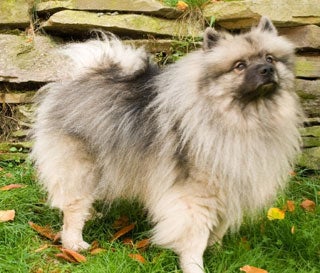Learn about dog breeds
Detailed information & photos on over 190 different breeds
Description
The Keeshond is a small breed known for its interesting coloration. The Keeshond has chestnut eyes, erect ears that are triangular and a tail that rolls over the back. They usually have a look of alertness.
The Keeshond head is wedge shaped with a medium muzzle and a long neck. The body is compact with a deep chest and straight forelegs. The feet are comparable o that of a feline with arched toes and black nails.
The walk of the Keeshond involves the tail staying in the curled position with sharp steps. When this breed is excited it will spin around in circles.
Coat Description
The Keeshond has a double coat with a ruff around the neck that is thick and full. Males will have a more distinct ruff than females. The Keeshond coat looks soft with a regal tail and feathered hair on the legs. The coat is straight with a part down the back.
History
The origin of the Keeshond breed is in the Arctic area. This breed comes from the Samoyed, Chow Chow, Elkhound and Pomeranian. It was a recognized symbol for commoners during the French Revolution. The rise in the breed’s popularity was when it was brought to the United States in the 1920s. The Keeshond has always been a dog of royalty and stature. They have been kept as pets by royal families and presidents in almost very country where they can be found.
Temperament
The Keeshond has a lot of energy and becomes excited very easily. They are known for spinning around when very excited. They are also loving and friendly. They are the type of dog who always looks happy.
This breed is a perfect family dog. It enjoys spending time with its family and being involved in family activities. They are great with children and other animals. They have superb hearing and can be a good little watchdog. They are also very loyal to their family and devoted to keeping them safe.
Sometimes the Keeshond can be shy. Good socialization as a pup, though, should break this tendency. They can become nervous and may show signs such as biting or nipping if feeling too uneasy. They may also suffer from separation anxiety which can lead to chewing and excessive barking.
Health Problems
The Keeshond is prone to health conditions common for small dogs. They may have problems like hip dysplasia and luxating. They can also suffer from conditions like epilepsy, Crushing’s Disease, hyperparathyrodism, hyperthyropidism and Von Willebrand’s Disease.
Grooming
The Keeshond requires some diligence in grooming. The thick, long coat needs plenty of care. They shed pretty heavy and will need constant brushing to help with the shedding process. Brushing also helps to prevent matting and remove tangles. It is important when bathing the Keeshond that care is taken to ensure all dead hair is removed prior to the bath. The bath should consist of using a dog shampoo. Special care should be taken to avoid getting soap around their eyes and ears. It is also important to make sure all soap is rinsed from the coat. Towel drying or a blow dryer can be used to dry the dog.
The ears need to clean well with a cotton swab and oil. The nails should be trimmed often and the hair on the feet should be trimmed as well.
Exercise
The Keeshond needs regular daily exercise due to their active nature. They should get at least an hour outside everyday. They like to run and should be kept active to avoid unwanted weight gain. The Keeshond does not do well in hot weather and should be watched during hot temperatures. Exercise may need to be limited to cooler times of the day.
Training
The Keeshond has several traits that make them a little challenging to train. They like to be independent and their energy level is through the roof. They also get bored quickly. Training the Keeshond is about learning the best method. With this breed training should be straightforward with little repetition. Since they like to please, positive reinforcement is best. They need a well structured training session that flows smoothly. The trainer needs to make sure the dog knows who is in control and that they need to pay attention.
Training is best started as a pup. Socialization is an important early training aspect. They need to be introduced to a variety of people, places and situations to help them be more outgoing and friendly without a tendency to be shy or reserved. They also will need to be taught that barking is only acceptable at certain times and not all the time. They also need to be taught that chewing is only for toys, not household items.
Training is best implemented when it includes fun aspects. The Keeshond is good at learning tricks and they should be brought into training sessions to help keep the dog from getting bored. Training is also a great way to increase the bond between owner and dog.
Advertise | Privacy Policy | Terms of Use | Contact Us © Copyright 2004-2024 PupCity.com. All rights reserved.
